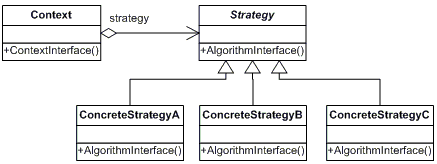Definition
Define a family of algorithms, encapsulate each one, and make them interchangeable. Strategy lets the algorithm vary independently from clients that use it.
Explanation
In computer programming, the strategy pattern (also known as the policy pattern) is a software design pattern that enables an algorithm’s behavior to be selected at runtime. The strategy pattern:
- defines a family of algorithms,
- encapsulates each algorithm, and
- makes the algorithms interchangeable within that family.
Strategy lets the algorithm vary independently from clients that use it. For instance, a class that performs validation on incoming data may use a strategy pattern to select a validation algorithm based on the type of data, the source of the data, user choice, or other discriminating factors. These factors are not known for each case until run-time, and may require radically different validation to be performed. The validation strategies, encapsulated separately from the validating object, may be used by other validating objects in different areas of the system (or even different systems) without code duplication.
Screencast
TypeScript Code
module Strategy {
interface ISortStrategy<T> {
sort<T>(items: Array<T>, comparer: (left: T, right: T) => number);
}
class StandardSortStrategy<T> implements ISortStrategy<T> {
public sort<T>(items: Array<T>, comparer: (left: T, right: T) => number) {
items = items.sort(comparer);
}
}
class InsertionSortStrategy<T> implements ISortStrategy<T> {
public sort<T>(items: Array<T>, comparer: (left: T, right: T) => number) {
var len = items.length;
if (len < 2) {
return;
}
var j = 0;
var previous: T, left: T = items[0];
for (var i = 1; i < len; i++) {
previous = left;
left = items[i];
j = (comparer(previous, left) <= 0) ? ++j : 0;
while (j < i) {
var right = items[j];
if (comparer(left, right) < 0) {
items.splice(i, 1);
items.splice(j, 0, left);
break;
} else {
j++;
}
}
}
}
}
class MergeSortStrategy<T> implements ISortStrategy<T> {
public sort<T>(items: Array<T>, comparer: (left: T, right: T) => number) {
if (items.length < 2) {
return items;
}
var sortedArrays: Array<Array<T>> = items.map((value) => { return [value]; });
var leftArray: Array<T>, rightArray: Array<T>;
while (sortedArrays.length > 1) {
leftArray = sortedArrays.shift();
rightArray = sortedArrays.shift();
var result = new Array<T>();
var left = leftArray.shift();
var right = rightArray.shift();
do {
if (comparer(left, right) <= 0) {
result.push(left);
left = leftArray.shift();
} else {
result.push(right);
right = rightArray.shift();
}
} while (left !== undefined && right !== undefined)
while (left !== undefined) {
result.push(left);
left = leftArray.shift();
}
while (right !== undefined) {
result.push(right);
right = rightArray.shift();
}
sortedArrays.push(result);
}
var sortedItems = sortedArrays[0];
for (var i = 0; i < items.length; i++) {
items[i] = sortedItems.shift();
}
}
}
class SortableList<T>{
private _items: Array<T> = new Array<T>();
constructor(items: Array<T>) {
this.sortStrategy = new StandardSortStrategy<T>();
this._items = this._items.concat(items);
}
public add(items: Array<T>) {
this._items = this._items.concat(items);
}
public get items(): Array<T> {
return this._items;
}
public sortStrategy: ISortStrategy<T>;
protected comparer: (left: T, right: T) => number = (left: T, right: T) => { return (left < right) ? -1 : 1; };
public sort() {
this.sortStrategy.sort(this._items, this.comparer);
}
}
class SortableNumberList extends SortableList<number>{
constructor(items: Array<number>) {
super(items);
}
}
window.addEventListener("load", function () {
var randomNumbers = new Array<number>();
var lenght = 50;
while (lenght--) {
randomNumbers.push(Math.round(Math.random() * 1000));
}
var sortableList1 = new SortableNumberList(randomNumbers);
sortableList1.sort();
Output.WriteLine("Sorted using the standard sort strategie:");
Output.WriteLine(sortableList1.items.join("|"));
var sortableList2 = new SortableNumberList(randomNumbers);
sortableList2.sortStrategy = new MergeSortStrategy<number>();
sortableList2.sort();
Output.WriteLine("Sorted using the merge sort strategie:");
Output.WriteLine(sortableList2.items.join("|"));
var sortableList3 = new SortableNumberList(randomNumbers);
sortableList3.sortStrategy = new InsertionSortStrategy<number>();
sortableList3.sort();
Output.WriteLine("Sorted using the insertion sort strategie:");
Output.WriteLine(sortableList3.items.join("|"));
});
}
Output
